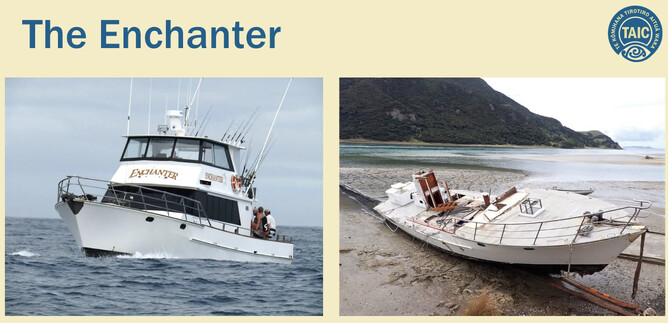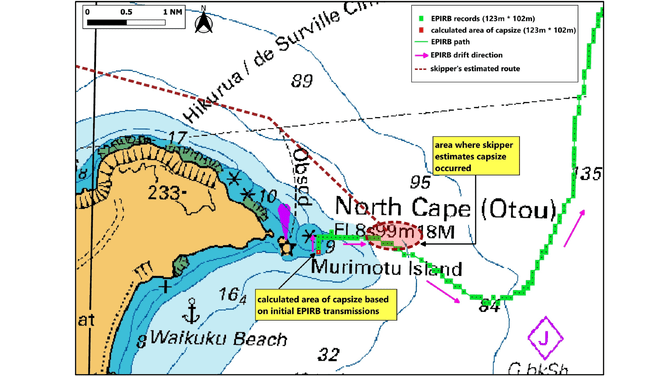NB: The below is a brief plain English summary of key points in the report. The Commission's report speaks for itself -- you can download the full document here:
www.taic.org.nz/inquiry/mo-2022-201
Key Points: The Commission has identified major safety issues affecting the marine sector nationwide, relating to:
Search and rescue: availability of aircraft; availability of fuel for SAR helicopters; and joint training for SAR organisations
Survivability: Maritime rules for stowage of life jackets to ensure easy access in an emergency
Tracking technology: tracking systems should be required on commercial vessels.
Marine surveys: How well vessel surveyors interpret and apply maritime rules.
What happened
The charter fishing vessel Enchanter, with eight passengers and two crew on board, capsized when it was struck a by large steep wave.
The crew activated an Emergency Position-Indicating Radio Beacon (EPIRB) and the New Zealand Rescue Coordination Centre (the RCC) initiated a search and rescue response.
The first rescue helicopter to arrive retrieved five people from the upturned hull and other floating debris. The bodies of the remaining five people were recovered after an almost two-day search and rescue operation involving multiple aircraft and surface vessels.
Why it happened
About as likely as not, Enchanter strayed into an area prone to occasional larger waves peaking as they entered shallowing water off Murimotu Island. When the wave rolled Enchanter onto its side, the force of water exceeded the superstructure’s design parameters and the superstructure separated from the hull, resulting in capsize.
Survivability
Three of the missing people were alive in the water when last seen by survivors but were later found deceased:
Flotation: nobody wore, or had immediate access to, life jackets; and life rafts likely did not automatically deploy.
Detectability: missing people would have been hard to see in the water at night. None of Enchanter’s four lifebuoys had effective retroreflective tape and only two had a strobe light attached. None of the stowed (but unused) life jackets had retroreflective markings and strobe lights.
Search delayed: There was significant delay in searching for the five missing people while fuel for the rescue helicopters was sourced.
Safety issues and recommendations for Maritime NZ
Marine surveyors professional practice: Vessels could be operating outside maritime rule requirements because Maritime New Zealand’s system for auditing and assessing accredited vessel surveyors doesn’t ensure correct interpretation and application of the rules.
Recommendation 017/23 (notify surveyors about changes to maritime rules)
Recommendation 018/23 (intent/application of maritime rules/standards)
Life jacket availability: Passengers and crew may be unable to access a life jacket in an emergency. Maritime NZ needs to make rules and/or guidance available to marine surveyors and vessel operators about this risk.
Tracking devices for commercial vessels: Search and rescue operations could be slow to start and inefficient in the absence of tracking devices. Maritime NZ should require commercial vessels carrying passengers outside inshore limits to be fitted with an automatic identification system or equivalent.
Recommendations to the Ministry of Transport
Dedicated search and rescue aircraft for remote operations: Lives may be lost if New Zealand’s search and rescue response is inadequate and inefficient due to lack of aircraft that are fully equipped and crewed for extended SAR operations in remote areas. MoT should coordinate with other agencies to identify and source air and maritime assets to meet NZ’s full SAR requirements. Consider potential dual uses.
Search & rescue personnel – knowledge and training: Good search and rescue operations depend on on-scene coordinators and Rescue Coordination Centre engaging in joint training to work to the same framework and use the same terms. MoT needs to delegate responsibility for standards for SAR assets and crews, and enter service level agreements for provision of SAR assets.
Recommendation 012/23 (delegation)
Recommendation 016/23 (joint training)
Fuel availability - effect on helicopter range: SAR operations could be delayed or prevented if SAR coordinating authorities don’t know and don’t understand national availability of fuel for extended helicopter SAR operations in remote areas. MoT should identify opportunities for supply and storage of fuel and maintain a database of stored fuel and fuel supply logistics. MoT and SAR coordinators should have procedures for asking helicopter operators about their maximum range and plans.
Recommendation 014/23 (fuel supply logistics)
Recommendation 015/23 (working with operators)
Safety Lessons
Skippers, mariners and owners:
If you can’t avoid navigating in shallow water in adverse wave conditions, be vigilant and expect waves larger and steeper than in deeper water
Stow life jackets around a vessel to be accessible in an emergency.
Fit a tracking device; you’ll be more likely to be rescued quickly.
During the safety briefing, get passengers to practice putting on a life jacket or demonstrate how to do so, rather than working it out in an emergency.
Passengers will be safer if they:
Wear an inflatable life jacket or similar buoyancy aid when fishing from an open deck in open and exposed waters
Wear a personal locator beacon in case you can’t get to the vessel’s EPIRB.
No repeat accidents – ever!
The principal purpose of the Transport Accident Investigation Commission is to determine the circumstances and causes of aviation, marine, and rail accidents and incidents with a view to avoiding similar occurrences in the future, rather than to ascribe blame to any person. TAIC opens an inquiry when it believes the reported circumstances of an accident or incident have - or are likely to have - significant implications for transport safety, or when the inquiry may allow the Commission to make findings or recommendations to improve transport safety.

